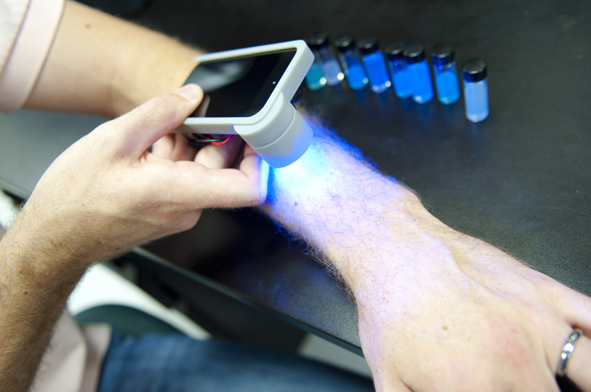Tattoos that improve health

Heather Clark isn’t your average tattoo artist. She won’t take requests, and her tattoos won’t be permanent. They won’t even make people look hip — but they will keep them healthier.
Clark, an associate professor of pharmaceutical sciences in Northeastern University’s Bouvé College of Health Sciences, is developing tattoos that involve nanosensors injected into an upper layer of the skin—a far less invasive, and thus less painful, process than a traditional tattoo.
She targeted this innovative approach to help diabetic patients continuously monitor glucose levels. The problem for many diabetics, she said, is they must measure their blood-sugar levels by pricking a finger several times a day—an agonizing, repetitive process that Clark said becomes more difficult when patients are traveling or trying to find a clean, private environment.
“They are tired of having to take time out of their lives to do this,” said Clark, noting calls she’s received from parents who say they stay up with their diabetic children every night because they are worried about a hypoglycemic event.
Now, she has published a paper in the journal Integrative Biology that applies the same concept to monitoring sodium levels, which she said can be useful to check kidney function during prostate surgery, and even to track long-distance runners’ hydration levels. Clark collaborated with Northeastern bioengineering graduate student Matt Dubach on the paper, which they coauthored with colleagues in California at the high-tech firm Caliper Life Sciences.
The project, which aligns with Northeastern’s commitment to research that solves global challenges in health, security and sustainability, aims to dramatically improve how certain health conditions are monitored and treated.
Clark said patients would reapply the tattoos about once a week. The process would involve injecting small beads containing fluorescent particles into the epidermal layer of the skin; the fluorescent glow would become more intense — and even change color — as glucose or sodium levels drop. Clark said that ideally, the levels would be monitored with a handheld electronic device.
Clark’s research primarily focuses on developing nanosensors, and the tattoo concept evolved out of her intracellular work at Draper Laboratories. She will continue collaborating closely with Draper researchers while at Northeastern.
“Tattoo artists basically poke holes and inject ink, which is made of particles, into the skin, where they reside for the rest of your life. Our sensors are nanoparticles, so it seemed like a natural choice to use these as a tattoo for monitoring health status,” she said.
View selected publications of Heather Clark in IRis, Northeastern’s digital archive.






